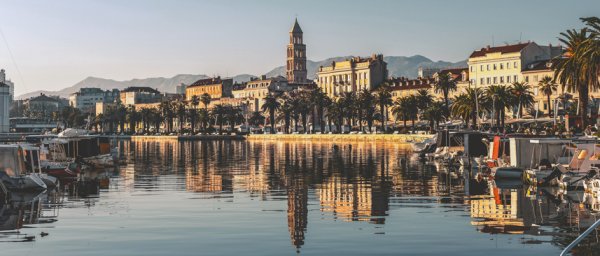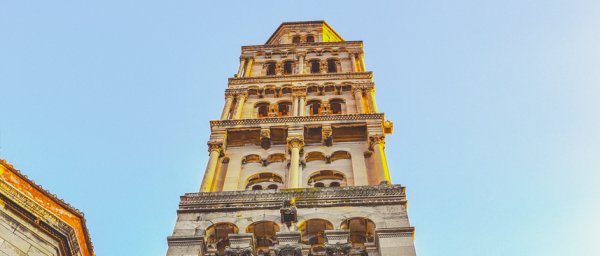22 July 2021 Places
What to visit in Split
The Mediterranean city in the heart of Dalmatia
Split is the second largest town in Croatia and has one of the three largest harbours on the Adriatic, creating a dominant position in the heart of Dalmatia.

The ancient spirit of Split and traditional care of its historic inheritance is the result of this city being inhabited for thousands of years. Romans were the first to come to this area, and their architecture stands to this day. Byzantines, Venetians and Austro-Hungarians followed. Rich history paired with sandy beaches and the azure sea provide an amazing resting place for people who want to engage in all kinds of activity.
Portal Through Time
Upon reaching the old town in Split, you will feel as if you have just gone through a time machine, back to a period thousands of years ago. You will not regret it. The most famous tourist attraction in this city is Diocletian’s palace which will take you back in time to when emperors walked the streets of Split. Indeed, Diocletian’s palace is in the city centre and around it evolved the rest of the city, turning in to the Split we know today. It was built somewhere between the 3rd and 4th century, and is often visited by tourists today for its beauty. The roman emperor himself retired to this palace and stayed in it until his death in 316. You can enter through the Golden Door and inside awaits a really mystic atmosphere.

Diocletian’s palace is home to the oldest cathedral in the world, the cathedral of St. Duja. Located at the centre of the palace, it was primarily Diocletian’s mausoleum. In the palace treasury there are priceless relics and objects of great historic value, and within it stands a famous bell tower that dominates the panorama of Split. On the Peristyle, the central square of Diocletian's Palace, you will come across a somewhat unusual but impressive monument. It is an Egyptian sphinx, about a meter high and made of black granite. The sphinx originates from Diocletian's time, and carries the urban legend that Diocletian was a kind of living deity. What distinguishes the Split sphinx from others and makes it unique is the sacrificial vessel located between its hands. In the complex of Diocletian's Palace, you can also find Diocletian's Cellars, the best preserved ancient complex of this type in the world. Although they were neglected over time, they have now been restored, reconstructed and readied to amaze tourists with their mysterious energy. These Cellars tell us nothing of their purpose in Diocletian's time, as evidence of this has not been preserved, but can be seen as a floor plan of the palace above them, as it is assumed that the layout of the rooms was identical. Cardo Street, which connects the southern and north-ern entrances to the Palace, passes partly through this area, but you can also visit the Cellars separately. Today, they are a place where concerts, exhibitions and fairs are often held.
Feeling the City’s Spirit by Simply Walking Through
You should begin your walk on the Riva, a beautiful pedestrian area by the sea, with local restaurants and cafes ready to accommodate you. This area is also surrounded by symbolic buildings. On this stretch are the Franciscan Monastery, the Procuratorate and the Port Authority building. The most beautiful part of day to spend walking down this street is at sunset, since you can hear the rustling of the leaves and the waves, along with the sunset which is simply breathtaking.
Riva is also the favoured place for locals to gather.

Another place that can’t be missed is the town square, the Pjaca. Charmingly tucked between the Rector's Palace and the City Hall, this square will make you think for a moment that you are in Italy. It is filled with people, locals and tourists, and can be the right place to have lunch after a long walk. If you want to mix with the locals and get better acquainted with their culture, the market will offer you a handful of content. Here you will feel the smell of fresh sea food, olive oil and cheese, which the local population imports from around the town each day. Try to “get lost” in the small narrow streets that surround the Pjaca, so you can feel like a real inhabitant of Split, even for a brief moment. Don’t forget to visit the statue of Gregory of Nin, a bishop from Split who reformed Catholicism in this town and who today is widely regarded a national hero. The sculptor is the famous Ivan Mestrovic, whose gallery can also be visited here. You will notice that many tourists touch the statue’s thumb. The custom is to make a wish while doing it, so why not try your own luck?
A Tour of Split’s Beaches Can Quickly Become an Adventure
For decades now, Split’s beaches have been the most popular tourist destination. These gravel and sand areas lure in tourists from every part of the Balkans. Among the most visited are Bačvice, Firule, Kasjuni, Bene, Kaštelet i Žnjan. Bačvice beach is the most popular because it is also the birthplace of Pigcin, a game which has found its way onto UNESCO’s list of cultural her-itage. This game is played in shallow water and the players pass around a ball which may not fall into the water. If you see people playing on the beach, stop up and take a look. The sight can be amazing because the passing is done through different acrobatics in the water. The Bene beach is a natural beauty of the Marjanska forest and is situated at its base. Žnjan is for families with children as it is spacious and has plenty of space for playing and family gatherings. In case you want to follow in the footsteps of the locals, visit Kasjuni beach. Many tourists regard it as being the most beautiful beach in Split, and is the first choice for locals. You can reach most of the beaches by car and the ones not so easily accessible you can reach by just walking for a few minutes. At these beaches you can find bars where you can refresh yourself.
Unforgettable Panoramas and Beautiful Nature Await You Outside Town
Only a few minutes away from the city is Marjan. This hill has been a refuge for travellers and is one of the bests sights Split can offer today. This whole area has been deemed a national reserve under the protection of the state, since it also possesses some historic landmarks: the Meštrović Gallery, the church of St Benedict and the church of St Jerome with the famous Hermitage. A good place for an outing during the day is the Sustepan peninsula, where there was a church and Benedictine cloister during the middle ages. There also used to be an impressive graveyard but it was destroyed by the communists following their rise to power. Since then, Sustepan has been transformed into a large park in which you can spend your day with your family or walking with friend.
Subscribe and don't miss out on our special offers.







